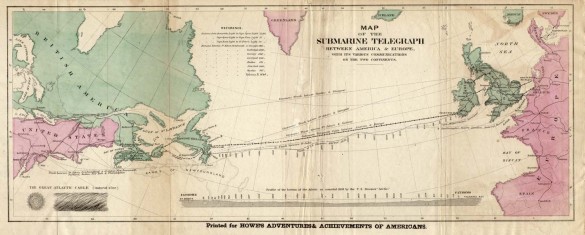
One hundred and forty-five years ago today (July 28, 1866), the first message was successfully sent across the first permanent transatlantic telegraph cable. Four unsuccessful attempts to lay a permanent telegraph cable across the floor of the Atlantic ocean occurred between 1857 and 1865. In 1858, the cable worked for almost a month before breaking. In 1866, the SS Great Eastern, contracted by the Anglo-American Telegraph Company, laid out 1,686 nautical miles of cable from Ireland to Newfoundland. “The cable consisted of seven copper wires, each weighing 26 kg/km (107 pounds per nautical mile), covered with three coats of gutta-percha, weighing 64 kg/km (261 pounds/nautical mile) and wound with tarred hemp, over which a sheath of eighteen strands, each of seven iron wires, was laid in a close spiral.”1 The SS Great Eastern laid out about 120 miles of cable per day over the course of its voyage. It arrived in Newfoundland on July 27, and the first message arrived the next morning, stating, “A treaty of peace has been signed between Austria and Prussia.”2
The transatlantic telegraph allowed levels and speeds of communication between North America and Europe never before obtained. Before the 1866 cable, messages took ten days to reach one continent from the other — one way. With the telegraph cable, about eight words per minute could be transmitted. Messages could be sent, and replies received, in one to two days.3 With our modern cell phones and our modern instantaneous communication speeds, this might not seem very impressive, but to people for whom sending a message and receiving a response had taken at least three weeks, this was an amazing jump forward. By the end of the century, business interest in America, Britain, France, and Germany had laid down nearly a dozen telegraph cables between the two continents. This paved the way for transatlantic telephone cables decades later. Transcontinental communications technology is yet another gift the European race has given to the world.
Other Inventions and Discoveries of the European race:
Footnotes
| Tweet |
|
|
|




